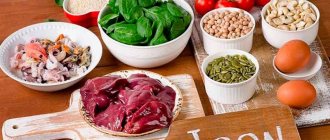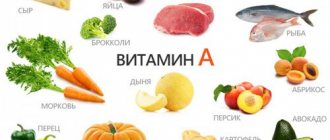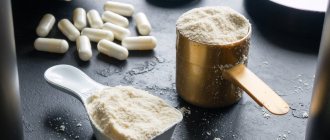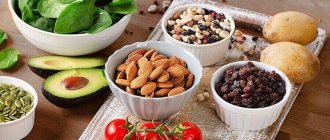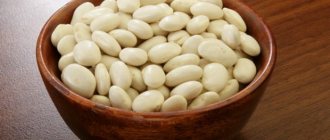Protein is the basis, the most important component of the organic body. Muscle fibers, most of the skin, and internal organs consist of protein (another common name is protein). A complex organic substance divided into 500 amino acids. What foods contain protein, which is so important for the body? Let's find out!
Foods vary in the amount of calories, protein, fat and carbohydrates. Protein-enriched sources help athletes formulate a nutritional plan to build muscle and maintain micronutrient balance. It is important to have knowledge of which foods contain a lot of proteins to meet the body's daily needs.
From this article you will learn:
- what is protein needed for?
- how many grams is the daily norm of a macronutrient;
- signs of component deficiency;
- a detailed list of which products contain protein of plant and animal origin;
- recommendations for menu planning.
The role of macronutrients in the body
Main functions of building material:
- Maintenance of muscle mass and most of the connective tissue of the muscles with the skeleton (cartilage along with other connective tissues). In addition, they form the cytoskeleton of cells, protecting and maintaining their shape.
- The basis of hormones. The lack of certain amino acids affects their production, causing a decrease in immunity, health, and development potential of the body. The biochemical reactions of the breakdown of nutrients (metabolism) are seriously affected.
- It is the building material of the connective tissues of the circulatory system. With a lack of even one type of amino acids, the vessels become fragile and cannot withstand high loads. It becomes difficult to stretch when pumping large volumes of blood. As a result, blood pressure increases, pain and fatigue occur.
- Protein cells of various crystal structures play a role in the cell signaling system and the body's immune response.
The substance is the basis for the structure of all internal organs. Especially the constantly working heart, which is the same example of muscle tissue.
High Protein Foods
The principles of proper nutrition provide for a special diet consisting mainly of protein foods. It is very important for the body, helps normalize weight, increase muscle mass and reduce fat. But the lack of this element can cause serious disruptions in the operation of all systems:
- weakness, lack of energy, loss of performance;
- decreased libido;
- low resistance to viruses and infections;
- disturbances in the functioning of the cardiovascular system, liver, pancreas, intestines;
- development of muscle atrophy, slowing of growth and development, especially in children.
Let's take a closer look at the questions about what protein is and where it can be found.
Daily protein intake
For a long time, medical science considered the consumption of proteins in combination with fats and carbohydrates according to the 1:1:4 principle, where carbohydrates accounted for the largest indicators. However, over time, the opinions of doctors changed due to the transformation of the diet in composition.
For healthy life, at least 0.7 grams of the component is required for every kilogram of a person’s weight per day. Those who play sports (especially bodybuilding, the goal of which is to increase the amount of muscle mass) increase their consumption to 1.5-1.7 grams. The protein balance should be as diverse as possible in amino acid content.
The proportions will vary based on the situation, diet and goals pursued. It is possible to increase the recommended volumes for men, women, and athletes, but there is no need for this. The question is exclusively individual and is related to beliefs, psychological and physiological (gastrointestinal reaction) comfort zones.
Portion distribution throughout the day
Distribution of food from the daily calorie intake according to the recommendations of nutritionists:
- breakfast – 30%;
- 2nd breakfast – 15%;
- lunch – 40%;
- afternoon snack – 5%;
- dinner – 10%.
Breakfast and lunch account for the largest percentage of protein; consumption can be omitted for afternoon snacks and dinner. If dinner consists of plant foods rich in fiber, then the body will have enough nutrients until the morning. It is recommended to take protein according to the following schedule:
- breakfast – 40%;
- 2nd breakfast – 10%;
- lunch – 40%;
- afternoon snack – 0%;
- dinner – 5%.
Protein-containing foods are distributed according to personal preferences. The schedule is advisory in nature.
If a person plays sports and builds muscle, the vector of consumption shifts closer to training. It is recommended to create a diet together with a trainer.
What are proteins? Meaning and main functions in the human body
Proteins (protein) are polymers that consist of amino acids. Proteins contain only 22 amino acids. Thanks to the various combinations of 22 amino acids, thousands of different proteins are built.
The importance of proteins is great. After all, it is the main building material of all organisms . As if all the tissues and organs of your body are built from protein bricks - heart, liver, kidneys, pancreas, blood vessels, muscles, hair, nails, etc.
In addition, proteins perform other important functions :
- Catalytic. Proteins are the main component of all known enzymes.
- Hormonal. Most hormones are proteins.
- Protective. A lack of proteins weakens the protective function because the immune system cannot function adequately.
- Transport. Proteins are involved in the transport of oxygen, carbohydrates, fats, some vitamins and microelements.
Signs of protein deficiency
A deficiency of food products necessary for the body manifests itself in the form of:
- A persistent desire to eat a certain food. As a rule, saturated with fast carbohydrates - sweets, pastries, chocolate. Coping with temptation is quite difficult, which is especially risky when losing weight.
- Sharp pain in muscles and joints. Having ruled out pathologies, it is recommended to track how much protein enters the body with food.
- Sleep disturbances, increased fatigue. The lack of a macronutrient is compensated by a carbohydrate product, which is processed faster than protein. As a result, hunger comes faster.
- Mood swings, moodiness, irritability. Exhausted by the lack of a component, the body lacks carbohydrate loading, which increases the degree of psychological stress, malaise, and moodiness.
The effect of deficiency on the body
Nutrient deficiency in an adult is accompanied by:
- vitamin deficiency;
- headaches;
- insomnia;
- hormonal disorders;
- decreased concentration and memory.
- For children, the deficiency manifests itself as:
- weight loss, exhaustion;
- slowdown in development.
Complete and incomplete proteins
In the process of digesting proteins from food, they are broken down into amino acids . These amino acids are then used to build the proteins the body needs. Thus, it is not just protein that is important to you, but the composition of amino acids.
Amino acids are divided into essential and non-essential . Replaceable ones can be synthesized in the human body. Essential ones , on the contrary, come only with food. For this reason, if there is a shortage of any essential amino acid, a certain protein will not be created, which will ultimately lead to certain consequences.
Proteins that contain all the essential amino acids in the required quantities are called complete .
Sources:
- egg whites;
- liver;
- milk and dairy products (except sour cream and butter);
- Fish and seafood;
- meat, poultry;
- soybeans
Proteins that contain only some of the essential amino acids are called incomplete .
Sources:
- grain crops;
- legumes (except soybeans);
- nuts and seeds;
- vegetables.
Protein content of available foods
To maintain a healthy lifestyle and proper nutrition, you don’t need to spend a lot of money. A visual table of foods that contain large quantities of protein:
| Name | approximate price |
| Buckwheat | from 60 rubles per 1 kg |
| Chicken | from 90 rubles per 1 kg (depending on the part) |
| Peanut | from 70 rubles per 1 kg |
| Peas | from 50 rubles per 1 kg |
| Chicken eggs | from 49 rubles for 10 pcs. |
| Processed cheese Karat | from 36 rubles for 1 piece. |
| Cottage cheese | from 60 rubles per 200 g |
| Lentils | from 140 rubles per 1 kg |
| Canned tuna in its own juice | from 80 rubles for 1 jar (185 g) |
Prices vary by region and depend on the manufacturer, seasonality, and the situation in the country. However, preparing a complete protein meal once a day is no more expensive than snacking on empty calories from fast food.
Daily consumption
Data on daily protein intakes vary. Different sources give figures from 40 to 90 g per day. In this case, one third of the diet should be animal proteins and two thirds should be plant proteins. But these nutritional standards may vary depending on the age category and the condition of the body. Thus, adolescents (from 13 to 16 years old) and young adults (up to 23 years old) are recommended to consume about 100 g of protein per day. Moreover, half of the norm should be obtained from animal food. Pregnant women and nursing mothers are recommended to consume about 110 g of protein per day. The diet of these groups must include fermented milk products, fish, and lean meat.
Animal sources
Meat and meat by-products are a quick way to obtain a spectrum of amino acids. It is animal protein that has the maximum fitness developed during evolution. This happened due to the constant presence of animals near people. Meat products often require long-term preliminary cooking - the protein is pre-split and becomes prepared for rapid absorption.
Of animal products, the maximum amount of protein contains:
- fish and seafood - tuna, hake, cod, shrimp, oysters, squid, etc. Sometimes up to 30 grams of macronutrients per 100 grams of weight;
- poultry - turkey, chicken;
- meat - beef, veal, pork, rabbit, lamb;
- offal - liver, heart, kidneys.
Proteins from meat
Meat products were not at the top of the rankings. However, they occupy average values ranging from 15-21 grams per 100 grams. Which is a much narrower range than that of plant foods. The different types of meat are arranged as follows:
| Source | Amount of component per 100 grams of wet weight |
| Turkey | 21,5 |
| Rabbit | 21,1 |
| Chicken | 21 |
| Mutton | 20 |
| Veal | 19,7 |
| Beef | 18,9 |
| Pork liver | 18,8 |
| Chickens | 18,7 |
| Beef liver | 17,4 |
| Pork kidneys | 16,7 |
It is worth noting that poultry meat has a much lower calorie content due to its lower fat content. In contrast, pork is extremely fatty – up to 25 grams.
Average content of important amino acids in meat:
- Tryptophan - 0.26;
- Lysine - 1.62;
- Phenylalanine - 1.65;
- Methionine - 0.86;
- Leucine - 2.40;
- Greonine - 0.86;
- Valine - 0.70;
- Arginine - 1.08;
- Histidine - 0.60;
- Isoleucine - 0.70.
From fish and seafood
Another high protein source is seafood. The benefit of fish and seafood consists of a greater amount of fat-soluble acids. Such acids are necessary for a person to maintain full functioning. Product rating:
| Source | Amount per 100 grams wet weight |
| Sturgeon caviar | 28,9 |
| Red caviar | 23,6 |
| Tuna | 22,7 |
| Chum salmon | 22 |
| Pink salmon | 21 |
| Shrimps | 20,9 |
| Salmon | 20,8 |
| Saira | 20,4 |
| Halibut | 18,9 |
| Squid | 18 |
Dairy sources
The milk itself contains a small amount of protein. The concentration is greater in derivatives - dairy products, when the cooking process is associated with the evaporation of excess moisture.
List of products containing milk proteins in descending order:
| Source | Amount per 100 grams wet weight |
| Cheese | 23-27 |
| Cottage cheese | 22 |
| Low-fat cottage cheese (5% and below) | 18 |
| Brynza | 17,5 |
| Kefir | 3 |
| Milk | 2,5 |
Cereals
The leaders among cereals in terms of macronutrient content are peas and chickpeas. One of the non-legume grains that is popular on the table is buckwheat. Conventional cereals contain a large amount of amino acids, especially when compared with milk:
| Source | Amount per 100 grams wet weight |
| Peas | 23 |
| Beans | 22 |
| Buckwheat core | 12,6 |
| Millet | 12 |
| Oatmeal | 11,5 |
| Wheat | 7,5 |
| Rice | 7 |
| Rye | 4,5 |
Vegetarianism and protein
Each person makes his own choice about how and what to eat. Vegetarianism has been gaining popularity in recent years. Increasingly, due to moral and ethical convictions, people refuse meat, or animal food in general.
If we talk about health, vegetarianism over the years leads to a sharp deficiency of many vitamins and microelements . First of all, this applies to vegans who completely refuse animal food.
They need to plan their diet very carefully to provide themselves with the necessary amount of essential amino acids. With the right approach, you can replace animal protein with plant protein.
For example, cereals contain little of the amino acid lysine and a lot of the amino acid methionine. Beans, on the contrary, are high in lysine and low in methionine. So consume both regularly. Although not necessarily in one meal.
You are recommended to eat a variety of plant foods: cereals, legumes (beans, lentils, peas and chickpeas), nuts, seeds, broccoli, etc.
Read more: Vegetarianism. How to stay healthy? Advice from professionals
Protein Digestibility
The most digestible compounds are found in products of animal origin, due to the need for heat treatment. Egg whites are completely digested, taking away the entire amino acid composition. Slightly less digestible:
- protein from milk (75-80%);
- meat (70-75%);
- fish (70-80%);
- legumes (45-55%);
- cereals (about 50-60%);
- vegetables (no more than 45%).
This is due to the content of amino acids that the digestive tract cannot process. The body is unable to use the compounds even when replacing missing amino acids.
Despite the fact that vegetable protein is much less digestible, the sources are rich in fiber and complex carbohydrates, which help in losing excess weight. The body is forced to process food over a longer period of time, so the feeling of hunger occurs a little later.
Plant foods containing protein
A plant, under the influence of the Sun, synthesizes amino acids from chemical elements obtained from the soil, produces carbohydrates, sugars, and starch. After digestion, plants do not poison the body with harmful compounds.
The following foods contain the most vegetable protein:
- legumes (soybeans, lentils, peas);
- grains (oats, barley, rice);
- nuts and seeds.
It is useful to include cabbage, carrots, eggplants, potatoes, and greens in your diet.
How to get essential amino acids:
- Eat a variety of protein plant foods.
Another way:
- Eat plant foods, but include some meat in your diet.
For example, cook beans, rice, pasta with veal, poultry or fish.
Options:
- chicken with rice;
- boiled beans with veal;
- rice with pink salmon;
- spaghetti with meat sauce.
List of the healthiest protein foods
Protein is not the most important component in food. It is necessary to maintain a balance of calories, the ratio of BZHU, nutrients. Therefore, you should not consider the most useful products based on protein indicators.
Food of animal origin contains vitamins and beneficial microelements. For example, B1-B12. It is very difficult to replace the role of a group of vitamins with similar foods.
To do this, eat meat, dairy products, and otherwise, get the elements with pharmaceutical drugs. However, pills sometimes have a negative effect.
Therefore, the main rule of diet planning is moderation and balance. You need to include dairy products, eggs, meat, vegetables, seafood. Then the food will contain a full range of substances necessary for the body, and the diet will become more varied.
10 foods with the highest protein content
If we take a comprehensive list of all known available items, taking into account plant sources and products of animal origin, the following rating will be formed:
- food gelatin;
- ground mustard;
- soy;
- pumpkin seeds;
- black caviar;
- peanut;
- Red caviar;
- cocoa powder;
- cold and hot smoked sausage;
- cheese.
Will the following list of products help you create a complete diet? Most likely it won’t work. Or the person will get “protein poisoning” (a common type of illness during a resort stay when eating seafood). But consuming gelatin, mustard, and soy is difficult: there is a risk of injuring the digestive tract, and the taste buds will completely fail.
Therefore, the menu is compiled not only from champions in terms of nutrient content.
TOP best high protein foods
What foods are rich in protein? The list is quite extensive and includes:
- meat, poultry, fish;
- dairy products;
- eggs;
- seeds, nuts;
- legumes;
- vegetables fruits.
From the listed representatives of protein foods, you can create a complete diet rich in vitamins and minerals. Let's take a closer look at the healthiest protein foods.
Protein-rich eggs and dairy products
Eggs and dairy products supply the human body with useful microelements, in particular calcium, and help improve digestion and intestinal function. The only people who need to be careful are people with individual lactose intolerance. But for them there is a separate line of lactose-free products.
Swiss cheese
Swiss cheese contains 25 grams of protein per 100 grams of product. In addition, it contains micro- and macroelements that are beneficial for the immune system, kidney and liver function.
It can be added to salads or hot dishes, made toast with the addition of lettuce and vegetables.
Cottage cheese
Cottage cheese contains 15 grams of protein per 100 grams of product. It is low in calories. In addition to protein, it contains a large amount of calcium, which is beneficial for bones.
Cottage cheese goes well with honey, fruits, berries, and dried fruits. It is ideal as a breakfast or first snack.
Egg whites
Eggs, namely whites, contain 12 grams of protein per 100 grams of product. They contain virtually no fat or cholesterol, which are dangerous for the cardiovascular system.
Eggs are an excellent option for a filling, healthy, proper breakfast. This meal will provide the body with energy and essential amino acids.
Tofu cheese
Tofu contains 9.9 grams of protein. It is often used as an alternative to meat products and is widely used in Indian cuisine. Tofu is rich in micro- and macroelements, in particular magnesium and iron, useful for the functioning of all body systems.
Cheese can be used to make toast, sandwiches, cold and warm snacks, and salads.
Greek yogurt
Greek yogurt contains 6.5 grams of protein. It is also rich in calcium and vitamin B12, which are essential for normal brain function, increased performance and concentration.
Greek yogurt can be used as an independent dish with fruits, berries or as a salad dressing, as it goes well with vegetables and seafood.
Soy milk
Soy milk is an ideal product for people with lactose intolerance. It contains 4 grams of protein per 100 ml of product.
Soy milk is often the basis of nutrition for vegetarians; it can be used to prepare porridges, add to protein shakes and smoothies.
High protein meat
Meat is the main source of protein, which is able to fully replenish the body’s need for essential amino acids necessary for the functioning of many systems. Let's take a closer look at the list of the most useful products.
Ground beef or chop
There are 21 grams of protein per 100 grams of beef, minced meat or chops. The amino acids included in the composition help normalize blood pressure, reduce the level of “bad” cholesterol, and also participate in the construction of muscle mass. It is enough to consume only two small cutlets, about 120-130 grams, to fill the daily requirement by half.
Pork chops
Pork contains, in addition to amino acids, a sufficient amount of zinc and other micro- and macroelements involved in many life processes. Regular consumption of lean, lean pork helps strengthen the immune system and enhance protective reactions. And per 100 grams of product there are 18 g of protein.
Turkey breasts
Turkey meat is considered the standard in the world of nutrition. It contains practically no fat, has low calorie content, and a sufficient amount of protein - 20 g per 100 grams of product. The meat can be boiled, stewed or baked with vegetables, or used to make homemade cutlets and meatballs. It is also recommended for infants as their first complementary food.
Chicken breast
Chicken fillet is a record holder for protein content, almost 24 g per 100 grams of product. It most often becomes the basis of a dietary menu, since it is accessible and inexpensive in comparison with other types of meat.
Chicken fillet goes well with vegetables and cereals, and can be used for soups, cold and hot appetizers, and main courses.
Seafood is a protein-rich food
Seafood is a very healthy food for the body, rich in essential amino acids, B vitamins, micro- and macroelements for the functioning of the thyroid gland, adrenal glands and gastrointestinal tract. Let's take a closer look at the most protein-rich foods.
Halibut
Halibut contains an impressive amount of Omega-3 poly-saturated fatty acids, which are actively involved in many processes occurring in the body, fighting cardiovascular diseases and high cholesterol levels. Contains 19 grams of protein per 100 grams of product
Sardines
Sardines contain 19 grams of protein per 100 grams of product, which is. At the same time, they are rich in omega-3 acids, selenium and iodine, which are necessary for the functioning of the nervous, cardiovascular systems, and brain. It is recommended to add to the diet of schoolchildren and mental workers.
Anchovies
Anchovies contain almost 30 grams of protein, which is. They are also rich in magnesium, calcium, phosphorus - essential elements in the construction of bone tissue.
Anchovies improve the condition of blood vessels, tone and strengthen them, which significantly reduces the risk of plaques and blood clots.
Octopus
Octopus is a rather exotic dish for Russians. It is difficult to find on store shelves, but it is recommended to periodically include it in the diet: the microelements contained in it act as antioxidants and reduce the number of free radicals.
There are almost 19 grams of protein per 100 grams of product. Octopus contains quite a lot of cholesterol, so the serving size should be small.
Yellow tuna
Tuna contains 23 grams of protein. At the same time, it is rich in vitamin E, which has a beneficial effect on the nervous system and brain function, increasing efficiency and concentration. It is very low in calories, making yellow tuna an ideal option for the menu.
tilapia
There are almost 20 grams of protein per 100 grams of tilapia. It is also a good source of calcium, which is good for healthy bones, teeth, nails and hair.
Fish goes well with various vegetables, side dishes of cereals, it can be baked in the oven or stewed in a saucepan.
Salmon
Salmon is a real storehouse of nutrients. It has a beneficial effect on all body systems: reduces inflammation, improves the functioning of the nervous and cardiovascular systems, and strengthens the immune system. There are 20 grams of protein per 100 grams of product. But you should know that salmon contains quite a lot of fat, so it is recommended to consume small portions - up to 150 grams.
High Protein Seeds and Nuts
Seeds and nuts contain the most protein from plant foods. They are rich in vitamins, nutrients, micro- and macroelements, which have a positive effect on the body as a whole.
Pistachios
Pistachios contain 20 grams of protein, which is about the same as fish and meat. In addition, they are rich in fiber, which improves digestion, peristalsis, and an antioxidant complex.
Quinoa seeds
Quinoa seeds contain almost 15 grams of protein per 100 grams of product, which is approximately. They are also rich in microelements, which have a powerful anti-inflammatory effect and reduce the risk of cancer.
Walnuts
Walnuts contain 15 grams of protein per 100 grams of product. They are rich in copper, which helps strengthen bones and improve brain function.
Walnuts can be added to yogurt, fruits, cereals, and dietary baked goods.
Cashew
Cashew nuts contain 22 grams of protein grams of protein per 100 grams of product. They are rich in copper and iron, which help improve blood composition, strengthen the walls of blood vessels, and immunity.
High Protein Grains and Legumes
Soya beans
Of all legumes, soybeans hold the record for protein content: 26 grams per 100 grams of product. In addition, they contain a full set of essential amino acids, prevent cardiovascular diseases, and improve digestion.
Dal (lentils)
Lentils are rich in plant fiber, folic acid, and calcium, which have a beneficial effect on the functioning of the heart, strengthen the walls of blood vessels, and improve the composition and quality of blood. Regular consumption of lentils helps reduce tiredness and fatigue. There are 19 grams of protein per 100 grams of product.
Rajma (red beans)
Red beans contain vitamin B1, which improves memory, prevents Alzheimer's disease, and also helps remove toxins from the body. 100 grams of product contain 21 grams of protein.
Red beans can be added to soups, salads, cooked yourself, or used canned.
Cereals
Oatmeal contains 12 grams of protein - the body's daily requirement. Oats are also rich in dietary fiber, which improves the functioning of the gastrointestinal tract.
You can cook porridge from the flakes, add them to muesli or smoothies.
High protein fruits and vegetables
Vegetables and fruits contain less protein compared to meat, fish and legumes, but they are very beneficial for the body because they contain dietary plant fiber and a rich vitamin and mineral complex.
Broccoli
Broccoli contains only 3 grams of protein per 100 grams of product, but it is rich in soluble fiber, which normalizes blood glucose levels and reduces the likelihood of type 2 diabetes.
Broccoli is ideal as a side dish for meat and fish products.
Asparagus
Asparagus contains aspartic acid, which has a diuretic effect and prevents urinary tract infections. In addition, it is a natural aphrodisiac, increasing libido. But per 100 grams there are only 2 grams of protein.
Cauliflower
Cauliflower is rich in choline, which stimulates memory, improves sleep, increases performance and concentration. It also contains sufficient amounts of fiber and water, which reduce the risk of constipation. But per 100 grams there are only 2.5 grams of protein.
Dried apricots (apricots)
Dried apricots and apricots are rich in potassium, iron and fiber, which reduce the risk of anemia and help strengthen the immune system and the body's resistance to viruses and infections. It is better to eat dried apricots or apricots with foods containing vitamin C, so they will be better absorbed by the body.
Protein content per 100 g of product is 1.5 grams for apricots, 5.2 for dried apricots.
Tangerines
Tangerines contain less than 1 gram of protein. But they are rich in flavonoids - substances that actively fight cancer cells and strengthen the immune system. They also strengthen the cardiovascular system.
Bananas
Bananas are rich in potassium, which helps lower blood pressure and strengthen the walls of blood vessels. They are also useful for intestinal disorders and help restore water and electrolyte balance. Protein content: 1.5 grams per 100 grams of product.
Avocado
Avocado contains folate, a substance that women need during pregnancy, as it significantly reduces the risk of miscarriage and premature birth. Regular consumption improves brain function and prevents depressive disorder. Protein content: 2 grams per 100 grams of product.
Fast squirrels
They are characterized by a rapid degree of digestibility. This characteristic is especially relevant when playing sports for the purpose of:
- restoring energy lost during training;
- replenishment of amino acid compounds;
- building muscle mass.
Athletes also use protein in sports nutrition format.
Absorption speed is 60-80 minutes. Next, the element breaks down into amino acids and enters the cells.
| Table of foods containing fast proteins | ||
| Ingredient | Quantity per 100 g | Degree of assimilation |
| Chicken egg | 13 | 1,0 |
| Milk | 3 | 1,0 |
| Cottage cheese (from 9% and above) | 18 | 1,0 |
| Cheese | 25 | 1,0 |
| Beef | 19 | 0,92 |
| Chicken | 21 | 0,92 |
| Pink salmon | 21 | 0,9 |
| Lean pork meat | 16 | 0,63 |
Signs of protein deficiency in the body and its excess
When the human body partially or completely does not receive proteins of animal origin, protein deficiency occurs. Signs of protein deficiency in the body may be the following:
- slight change in body weight;
- dry, pale skin, decreased elasticity;
- diarrhea;
- irritability and apathy;
- slight memory loss;
- absentmindedness;
- decreased performance;
- decreased immunity;
- loss of appetite;
- deterioration of hair condition;
- lowering blood pressure;
- slow pulse;
- decrease in lung volume;
- swelling.
Popular site article: How to treat bloating and gas at home
But there is also the opposite side, when there may be an excess of protein in the body, which also leads to negative consequences. Signs of excess protein are:
- there is pain in the area of the kidneys and liver;
- joint pain;
- tooth loss;
- slow metabolism, which contributes to the appearance of fat mass;
- intestinal disorders;
- fast fatiguability;
- nervousness and excitability;
- cholesterol levels increase;
- the risk of bone fractures increases;
- decreased performance.
Slow proteins
The compound is absorbed and broken down over a long period of time. Helps prevent catabolism, promotes long-term satiety, which is useful on a weight loss diet.
Absorption rate is 6-8 hours. Recycling requires more energy. It is recommended to include it in the evening meal to reduce the number of calories consumed and provide muscles with nutrients during sleep. The list contains mainly herbal ingredients.
| List of foods containing sources of slow protein | ||
| Ingredient | Quantity per 100 g | Degree of assimilation |
| Cottage cheese (from 5% and below) | 18 | 0,7 |
| Beans | 22 | 0,68 |
| Peas | 23 | 0,67 |
| Buckwheat | 13 | 0,66 |
| Corn | 8 | 0,63 |
| Oats | 12 | 0,57 |
| Rice | 7 | 0,55 |
| Peanut | 26 | 0,52 |
The basis of slow protein is casein, which is found in low-fat varieties of cottage cheese.
Protein distribution during the day
It happens according to two main schemes:
First. Involves distributing high-protein foods into five servings that are eaten throughout the day.
Second. For breakfast and dinner they eat 20%, and for lunch - 45% protein. The rest of the daily intake is distributed 5% for snacks after main meals.
Regardless of the chosen scheme, you should take into account that each serving should be no more than 300-350 g. The main thing is to choose the products that suit your taste the most.
Products for gaining muscle mass
It is possible to increase the number of muscle fibers by following a training regimen, taking time to recover and balancing your diet. If we talk about nutrition, then gaining muscle mass is possible only if there is a sufficient supply of nutrients from food.
The daily caloric intake should be higher than the energy expended during the day. Macronutrients in the athlete's menu on the set are considered mandatory. Nutrient ratio:
- proteins – 23-35%;
- fats – 15-25%;
- carbohydrates – 40-60%.
To eliminate the risk of excessive fat gain along with muscles, it is recommended to give preference to high-quality natural products:
- chicken, turkey fillet;
- lean beef, veal;
- cottage cheese;
- eggs;
- sea fish, seafood;
- legumes;
- nuts;
- sports nutrition.
Benefit
The human body cannot exist without a constant supply of protein substances. After all, the structural, regulatory, and transport proteins of the body must be constantly updated. The lifespan of many enzymes is several hours, and structural proteins (from which cells are built) live for 2-3 days.
The benefits of protein foods for the body are obvious:
- Protein-rich foods help maintain healthy and attractive appearance of hair, skin, and nails
- a diet with a balanced content of protein substances ensures normal synthesis of enzymes, protective proteins (immunoglobulins), helps maintain normal hormonal levels
- Protein foods provide the body with energy during increased physical activity
- Protein substances promote weight loss, since the body spends more energy on the breakdown of protein than on the breakdown of carbohydrates or fats
Plant or animal sources?
There is regular debate about the benefits of protein. Discussions are connected with the spread of vegetarianism among athletes and amateurs.
A record amount of protein is found in animal products. It is found in large quantities in meat, fish, and offal. However, plant foods contain healthy proteins and a unique amino acid composition.
A person needs 20 amino acids, but the body itself creates only 12. The rest must be obtained from food. Among the remaining compounds, four are essential, which cannot be replaced by other amino acids when building the chain of a protein molecule.
Plant protein is more diverse, however, it is the saturated fat-soluble amino acids that are concentrated in limited proportions in plants. For proper nutrition, you need to carefully formulate your diet.
The benefits of plant foods
It is not in vain that the search for a replacement for animal sources of protein is underway. The desire to diversify the diet is associated with the desire to reduce the amount of harmful substances coming from foods. Along with meat, the body receives a lot of fats, and modern livestock farming supplies animals with hormones for various purposes.
The result is the accumulation by the body of hormones that are not characteristic of humans, having a protein form. The nutrient is not absorbed entirely and is not excreted during digestion. Do not forget about the intake of cholesterol from meat, which is produced in small quantities by the body itself.
Plant foods do not have this effect and promote a healthy diet, and due to fiber, calorie intake is reduced.
How to replace animal protein
First on the list are legumes, which allow you to improvise in cooking and add variety to your diet. The most common:
- beans (6-12 grams of protein per 100 grams of product);
- peas (up to 8 grams).
More nutritious:
- lentils (up to 25 grams);
- chickpeas (15-19 grams).
Soybeans are considered beneficial because they contain a full range of amino acids that enter the body with meat. The product can be found in the form of soy cheese (tofu), soy milk, meat. The products have a similar base.
In addition to legumes, the leaders are:
- sunflower seeds (about 20 grams);
- peanuts (up to 25 grams);
- almonds (up to 21 grams);
- sesame (about 19 grams).
Types of proteins
By origin, all proteins can be divided into two large groups: animal and plant. The following table shows the main points you need to know about these groups.
| Animal origin | Vegetable origin | |
| Main advantage | They are considered complete because they contain all the essential amino acids. | Stimulates intestinal function, improving peristalsis. |
| What do they contain? |
|
|
| What are the disadvantages? | Some sources of animal protein, particularly red meat, contain saturated fat and cholesterol, which increase the risk of heart disease. In addition, it is difficult to find a quality product in modern stores: meat usually contains traces of pesticides, antibiotics, and growth hormones, which can negatively affect health. | Plant-based products contain very little protein when compared to animal products. To reach your daily requirement, you will have to eat a huge amount of vegetables and fruits. Vegetarians need to understand this: vegetable protein is not considered complete, because it is not able to replenish essential amino acids. |
Protein foods - food list
Above we gave a list of protein foods with their calories, fats, carbohydrates and protein content. Here is another table of protein foods with protein content per 100 grams of product:
- Egg powder - 45.0;
- Cheese cheese - 18.0;
- Hard and processed cheese - 23.4-29.0;
- Cheesecakes, casserole - 16.4-18.9;
- Liver pate - 18.0;
- Canned meat - 15.0-20.0;
- Cutlet, chop - 20.0;
- Soy protein isolate - 90.0;
- Ham - 22.6;
- Lamb kebab - 22.9;
- Cervelat - 24.0;
- Smoked salmon - 25.4;
- Pasta - 10.0–11.3;
- Beefsteak - 28.8;
- Sausage mince - 15.2;
- Cottage cheese - 14.0–18.0;
- Boiled veal - 30.7;
- Ham - 14.3.
What can a vegetarian replace meat with?
Dairy and fermented milk products
Cottage cheese.
Let's say right away that cottage cheese is not a complete meat replacement; it lacks omega-3 polyunsaturated fatty acids, but cottage cheese contains a lot of protein. Moreover, the less fatty the cottage cheese, the more protein it contains. Low-fat cottage cheese has a higher protein content. But cottage cheese is the most perishable product; it is stored for only 3 days, then it can develop E. coli, which harms our body. Cottage cheese sold in stores has a longer shelf life, approximately 5-7 days. This is achieved by heat treatment of cottage cheese. But this treatment kills not only microbes, but also beneficial substances. The shorter the shelf life of cottage cheese, the healthier it is.
Pharmacologist, nutritionist, leading biochemist in Europe in the field of oncology research, Dr. Johanna Budwig, who was a candidate for the Nobel Prize 7 times and was a vegetarian, selected a therapeutic diet for cancer patients using a mixture of cottage cheese and organic flaxseed oil. Flaxseed oil contains a lot of Omega-3, it is easily digestible and does not cause allergic reactions. Cottage cheese contains a lot of sulfoproteins. Budwig found that this combination made it easier for the body to absorb flaxseed oil. Consumption of flaxseed oil alone is useless. Budwig recommends: add 2 tablespoons of cold-pressed organic flaxseed oil to 100-150 grams of cottage cheese once a day.
Yogurt (Greek, low fat).
Greek yogurt helps burn fat and increase muscle growth. The product also contains probiotics - bacteria that, when colonized in the intestines, participate in the digestion of food and the formation of immunity.
Eating fermented milk products every day helps you forget about intestinal problems, because they contain many beneficial microorganisms for the intestinal microflora. Milk (powdered/skimmed).
Powdered milk consists of 80% casein, therefore it is used by athletes as a slow protein.
Cheese.
Parmesan cheese is especially rich in protein. Goat cheese, in addition to protein, is also rich in vitamins and microelements. Soft feta cheese is convenient to use in salads.
Protein content in milk and fermented milk:
- Parmesan cheese - 38 g of protein per 100 g.
- Milk (powdered/skimmed) - 26 g of protein per 100 g.
- Low-fat cottage cheese - 22 g of protein per 100 g.
- Goat cheese - 22 g of protein per 100 g.
- Cottage cheese 5% - 21 g of protein per 100 g.
- Cottage cheese 2% - 20 g of proteins per 100 g.
- Cottage cheese 9% - 18 g of protein per 100 g.
- Cottage cheese 11% - 16 g of protein per 100 g.
- Cottage cheese 18% - 15 g of protein per 100 g.
- Feta cheese - 14 g of protein per 100 g.
- Greek yogurt - 10 g protein per 100 g.
- Kefir - 3 g of protein per 100 g.
Tips and tricks
In order for protein foods to bring only benefits to the body, you should follow a few simple recommendations:
- you should not completely give up animal proteins; it is advisable that your diet contains at least fermented milk products; for those who adhere to strict vegan diets, it is necessary to compensate for the lack of essential amino acids with the help of pharmaceutical preparations or complex dietary supplements
- It is extremely undesirable to compensate for the lack of protein with purified protein powder, which creates additional stress on organs such as the kidneys and pancreas and disrupts the functioning of the digestive tract
- Animal proteins must be present in the diet of pregnant and lactating women and children
Now protein diets have come into fashion, helping to lose weight quickly and without much discomfort. But here you need to remember that excess protein contributes to the removal of some important microelements from the body, in particular calcium. This leads to bone fragility and the development of osteoporosis. Therefore, you should use protein diets only after consultation with your doctor.
What is the difference between plant and animal proteins
To answer the question of what is the difference between animal protein and plant protein, let’s return to the definition of proteins. Protein is made up of amino acids. It is the sequence of amino acids that determines the properties of a protein (source - Wikipedia).
Amino acids are divided into replaceable and essential. They have this property exclusively in relation to the human body. Replaceable ones can be synthesized by our body, irreplaceable ones cannot, they can only be obtained through various foods.
The first group includes arginine, alanine, asparagine, tyrosine, glycine, proline, glutamine, glutamic acid, aspartic acid, cysteine, serine. Essential ones include valine, leucine, isoleucine, lysine, tryptophan, threonine, methionine, phenylalanine, histidine.
© VectorMine — depositphotos.com
This information will help you understand what a complete protein is. Only a protein that contains a full set of amino acids is considered such. Why does a person need a complete set? The fact is that we need protein as such precisely as a source of amino acids. Only protein broken down into amino acids is used by the body as a structural material.
Assimilated amino acids formed during the breakdown of “foreign” protein will be used for the synthesis of the body’s own proteins - tissues, hormones, enzymes, cellular organelles, etc.
So, vegetable protein is an incomplete protein . It is depleted in essential amino acids and does not contain the full spectrum of compounds necessary for humans. That is why vegetarian athletes need to clearly understand which foods contain which amino acids in order to create a complete protein diet by “mixing” various plant sources of protein (source – NCBI – National Center for Biotechnology Information).
How to calculate your protein needs
To figure out exactly how much protein is needed for stable growth, it is worth considering several factors that are often ignored:
- Clean weight without fat. This way, fantastic numbers will turn into very real and acceptable ones. Net weight is calculated using the formula: total weight -% body fat. And from this the total protein intake is calculated.
- Metabolic rate. People with slow metabolisms need on average 30% less protein structures than individuals with fast metabolic processes.
- Amino acid composition of protein. If you eat complex protein, calculate the data according to the table. But if you follow a vegetarian diet and work with plant protein, try to fill out the full amino acid profile. To do this, count only half of the incoming protein from each amino acid profile.
The table shows protein needs depending on physical activity:
| Average protein intake per day | Intensity of physical activity |
| 0.3-0.5 g of protein per kg of body weight. | To maintain normal functioning without physical activity |
| 0.7-1 g | To maintain stable muscle tissue levels during the initial stages of iron training |
| 1- 1.2 g | For a gradual gain of muscle mass under conditions of stable physical activity and caloric excess of no more than 10% of consumption |
| 1.5-2 g | For a gradual gain of muscle mass under conditions of stable physical activity, in conditions of a slight calorie deficit (up to 10% of total consumption) |
| 2-2.5 g | To preserve muscle tissue in harsh drying conditions |
Let’s immediately make a reservation that consuming more than 2 g of protein per kg of body weight requires additional consumption of water - 30 ml for each gram of protein.
We recommend interesting material about the protein diet!
Animal protein intolerance
Some people suffer from hypersensitivity to certain foods. In particular, allergies can occur to animal protein contained in meat. Often an allergic reaction is cross-reaction, that is, at the same time there is, for example, intolerance to beef and cow's milk or chicken meat and eggs.
The body reacts negatively to large amounts of protein, and the allergy is usually hereditary. Other reasons include:
- weak immunity;
- long-term antibiotic therapy;
- history of severe infectious and chronic diseases.
Intolerance to animal proteins not only causes a variety of allergic manifestations, but can also provoke anaphylactic shock. Therefore, you should take a responsible approach to preparing your diet and choosing protein sources.




